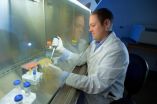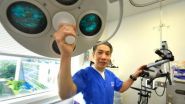New targets for treating pulmonary hypertension found
2014-09-08
(Press-News.org) Two new potential therapeutic targets for the treatment of pulmonary arterial hypertension, a deadly disease marked by high blood pressure in the lungs, have been identified by researchers at the University of Illinois at Chicago. Their findings are reported in the American Journal of Respiratory and Critical Care Medicine.
Early symptoms of pulmonary arterial hypertension include shortness of breath and exercise intolerance. As the disease progresses, patients may require oxygen supplementation and lung transplantation. Heart failure can develop and is a major cause of death in the disease.
Most cases of pulmonary hypertension are of unknown cause, though the condition often occurs in association with other diseases, including scleroderma, congenital heart disease and liver disease. One of the underlying factors driving the increased blood pressure in the lungs is a narrowing of the pulmonary blood vessels. This narrowing can be due to an abnormal proliferation of cells within the walls of the blood vessels, particularly in the smooth muscle cells of the pulmonary artery.
Jiwang Chen, research assistant professor of critical care medicine, sleep and allergy in the UIC College of Medicine, and his colleagues investigated the molecular mechanisms behind the abnormal proliferation of smooth muscle cells in the pulmonary artery and discovered two ways that the proliferation could be suppressed.
They knew that an enzyme, sphingosine kinase 1, that produces a signaling molecule called sphingosine-1-phosphate (S1P), had been linked to the abnormal growth of cells in cancer, including lung cancer.
"The characteristic proliferation of cells that line the blood vessels in pulmonary hypertension is similar to the abnormal growth and reproduction of cells that form cancerous tumors," says Chen. "We wanted to see if sphingosine kinase 1 and S1P were involved in the development of pulmonary arterial hypertension."
Looking at samples of lung tissue from patients, Chen and colleagues found that patients with pulmonary arterial hypertension had significantly elevated levels of both the enzyme and the signaling molecule it produces. They found similarly elevated levels of both molecules in mouse and rat models of pulmonary hypertension.
Knockout mice lacking the gene for sphingosine kinase 1 were less likely than normal mice to develop pulmonary hypertension when exposed to the low-oxygen conditions used to induce the disease in the laboratory.
Drugs that either suppress production of sphingosine kinase 1 or block the signaling of S1P through its receptors on smooth muscle cells prevented mice from developing pulmonary hypertension in low-oxygen conditions.
The researchers also showed in mice that over-production of sphingosine kinase 1 and S1P promote the proliferation of pulmonary artery smooth muscle cells.
"Our results yield two new potential targets for the development of drugs to treat or prevent the progression of pulmonary arterial hypertension," Chen said.
"By blocking the binding site for S1P or suppressing the production of S1P, like we did in our experimental rodent model, we can reduce the proliferation of pulmonary artery smooth muscle cells, which is a major contributor to pulmonary hypertension."
INFORMATION:
Drs. Roberto Machado, associate professor of pulmonary, critical care, sleep and allergy in the UIC College of Medicine, and Viswanathan Natarajan, professor of pharmacology in the UIC College of Medicine, are senior authors on the paper. Other authors are Haiyang Tang, Justin Sysol, Liliana Moreno-Vinasco, Krystyna Shioura, Tianji Chen, Irina Gorshkova, Lichun Wang, Peter Usatyuk, Longshuang Huang, Saad Sammani, Guofei Zhou, Dr. Usha Raj, Dr. Joe G.N. Garcia, Evgeny Berdyshev and Dr. Jason X. J. Yuan. All authors are or were at UIC when the research was conducted.
This research was supported by grants R01HL111656, K23HL098454 and P01HL98050 from the National Heart, Lung and Blood Institute; a UIC Area of Excellence Award; and a Pulmonary Hypertension Association Proof-of-Concept Research Grant.
ELSE PRESS RELEASES FROM THIS DATE:
New compound inhibits enzyme crucial to MERS and SARS viruses, with a catch
2014-09-08
Scientists at the University of Illinois, Chicago, have identified a compound that effectively inhibits an enzyme crucial to the viruses that cause Middle East respiratory syndrome (MERS) and severe acute respiratory syndrome (SARS). The compound appears to have a different method of inhibition in each virus due to slight differences in each virus' enzyme which means finding other compounds that inhibit both may be difficult according to research presented at the 54th Interscience Conference on Antimicrobial Agents and Chemotherapy (ICAAC) an infectious disease meeting ...
How quickly viruses can contaminate buildings and how to stop them
2014-09-08
Using tracer viruses, researchers found that contamination of just a single doorknob or table top results in the spread of viruses throughout office buildings, hotels, and health care facilities. Within 2 to 4 hours, the virus could be detected on 40 to 60 percent of workers and visitors in the facilities and commonly touched objects, according to research presented at the 54th Interscience Conference on Antimicrobial Agents and Chemotherapy (ICAAC), an infectious disease meeting of the American Society for Microbiology.
There is a simple solution, though, says Charles ...
A low-energy optical circuit for a new era of technology
2014-09-08
Unlike electronic circuits, optical, or "photonic", circuits work with light rather than electricity, which makes them 10 to 100 times faster. They are also more energy-efficient because they show lower heat loss, better signal-to-noise ratios and are less susceptible to interference. Used especially for communications (e.g. fiber optics), optical circuits may use tiny optical cavities as 'switches' that can block or allow the flow of light, similarly to transistors in electronics. EPFL scientists have now fabricated and experimentally tested a silicon-based 'photonic crystal ...
To admit or not to admit: Variation in hospitalizations from ER costs billions
2014-09-08
ANN ARBOR, Mich. — It sounds like the setup for a joke: Two identical patients go to two different hospital emergency entrances, complaining of the same symptoms.
But what happens next is no laughing matter, according to a new University of Michigan study published in the September issue of Health Affairs. While one patient may get treated and released from the emergency department, the other gets sent upstairs to a hospital bed – at a cost of tens of thousands of dollars.
In fact, doctors at one hospital may be as much as six times as likely to admit an emergency ...
Scientists reveal cell secret potentially useful for vaccines
2014-09-08
The best defense is a good offense, especially when it comes to the immune system. The troops that respond to an infection are split into two squadrons, and, until recently, it seemed that the two were independent, without much interaction.
Now, in a paper published this week in Nature Immunology, a team of scientists from the Virginia Tech Carilion Research Institute and the University of Alabama at Birmingham say that the immunology boot camp is more communication-intensive than initially thought — a discovery that could help efforts to produce more effective vaccines.
"We ...
Women and health professionals spark new cycle of improving maternal and newborn health
2014-09-08
Demand for better care by women linked with the expansion of basic services, rather than political pressure, has helped to improve midwifery services in low to middle-income countries, according to international research involving the University of Southampton.
An examination of maternal and newborn health systems for the Lancet Series on Midwifery found that after initial investment in maternal and newborn health infrastructure, a virtuous cycle developed in these countries – with increased demand for care leading to the deployment of more midwives, better services, ...
Facial plastic surgery can safely address the major aspects of aging in 1 operation
2014-09-08
AUGUSTA, Ga. – A total facial rejuvenation that combines three procedures to address the multiple signs of an aging face and neck can be performed safely at one time, a new study shows.
Total facial rejuvenation, which combines an extensive facelift to tighten skin and muscle; specialized, midface implants to restore fullness; and laser resurfacing to reduce skin's irregular texture and discoloration, can be safely performed at one time, reports Dr. Achih H. Chen, facial plastic surgeon.
Chen, Director of Facial Plastic and Reconstructive Surgery at the Medical ...
Enigmatic Viking fortress discovered in Denmark
2014-09-08
It is the first time for over 60 years that a new Viking fortress is found in Denmark, says curator Nanna Holm of The Danish Castle Centre. Søren Sindbæk, professor of medieval archeology at Aarhus University, explains: "The Vikings have a reputation as a berserker and pirates. It comes as a surprise to many that they were also capable of building magnificent fortresses. The discovery of the new Viking fortress is a unique opportunity to gain new knowledge about Viking war and conflicts, and we get a new chance to examine the Vikings' most famous monuments. " The previously ...
Bureaucracy consumes one-quarter of US hospitals' budgets, twice as much as other nations
2014-09-08
A study of hospital administrative costs in eight nations published today in the September issue of Health Affairs finds that hospital bureaucracy consumed 25.3 percent of hospital budgets in the U.S. in 2011, far more than in other nations.
Administrative costs were lowest (about 12 percent) in Scotland and Canada, whose single-payer systems fund hospitals through global, lump-sum budgets, much as a fire department is funded in the U.S.
The study is the first analysis of administrative costs across multiple nations with widely varying health systems. It was carried ...
Climate change to increase forest fire danger in Europe
2014-09-08
Climate change is expected to bring increased temperatures and longer droughts—conditions that will make forests more susceptible to fires.
By 2090, the area burned by forest fires in the European Union could increase by 200% because of climate change, according to a new study published in the journal Regional Environmental Change. However, preventive fires could keep that increase to below 50%, the study shows. Improved firefighting response could provide additional protection against forest fires.
The study was the first to examine adaptation to forest fire danger ...



